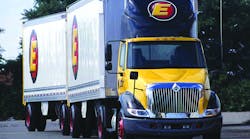In a long-haul, less-than-truckload (LTL) scenario, linehaul operations account for most of the cost of moving freight,” says Paul Dugent, vice president of pricing at Estes Express Lines. “In a short-haul or regional LTL operation, linehaul costs are a smaller percentage and P&D costs make up the larger portion.”
The biggest challenge Dugent identifies is a lack of sufficient information from shippers. “If we have to rely solely on shippers’ data, most will not likely be able to give us all the information we require to make accurate pricing decisions,” he states.
“Incomplete information forces us to make assumptions that lead to less aggressive pricing, and it’s only after we handle the freight do we know if we’re correct,” Dugent adds. “If we don’t get the pricing right, we may have to go back to the shipper to renegotiate and that’s something nobody likes to do.”
Headquartered in Richmond, VA, Estes Express Lines operates a network of 210 regional freight terminals to cover more than 750 million one- and two-day P&D points. The facilities, located in six service regions in the U.S., also provide 50-state coverage for almost 900 million two- and three-day origin/destination pairs. The carrier’s fleet of over 6,600 tractors and nearly 25,000 trailers handles more than 10.3 million shipments annually.
Effective costing of freight at Estes is supported by National Motor Freight Traffic Assn.’s National Motor Freight Classification (NMFC) standard. Under the NMFC standard, commodities are grouped into one of 18 classes based on an evaluation of four transportation characteristics: density, handling, stowability and liability.
“The NMFC provides a standard by which to cost shipments,” Dugent relates, “and density is the primary characteristic we use because it is the one factor that addresses both weight and cubic capacity. For each type of freight, density tells us in pounds per cubic foot how the shipment will occupy the capacity of a trailer.
“That enables a more effective allocation of the linehaul cost of a shipment,” Dugent says. “Knowing how freight from different shippers can be comingled in a trailer is essential for fully utilizing space and staying within legal weight limits. Any empty space is perishable, and it impacts our costs and our profitability.”
To equitably allocate costs between multiple shippers in an LTL load, and model its profitability for specific hauls, Estes Express Lines is using the LTL Cost Information System (CIS) from Transportation Costing Group. The software model designed for LTL carriers with terminal networks combines traffic and financial information with carrier and/or industry performance standards. For example, freight bills or user-built shipment description files are used to develop specific cost information for pricing and for profitability analyses.
“The LTL/CIS cost model gives us unit costs developed directly from our own data,” Dugent states, “and we can configure the software to provide pricing using budgeted or projected unit costs. Costing models help us do our level best to provide an accurate price based on the information available.”



